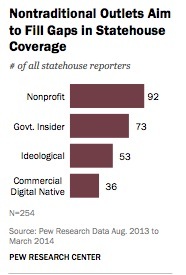
The Georgia state legislature passed 322 bills during its 2014 legislative session that ended in March. From a bill that eased restrictions on guns in churches, bars, and schools to one that would require some food-stamp recipients to take drug tests, much of the legislation that passed will directly impact the lives of Georgia’s 10 million residents.
Despite the importance of what transpired at the statehouse, there were only 17 full-time reporters covering the legislature, according to a study released this morning by the Pew Research Center examining changes among the statehouse press corps across the United States.
Though Georgia was one of the few states to actually see an increase in statehouse reporters in recent years, the total number of newspaper statehouse reporters fell 35 percent between 2003 and 2014, outpacing the 30 percent decline in overall newspaper newsroom staffing over that time, the study finds. And as statehouse coverage from traditional news outlets has receded, there’s been an influx of for-profit and nonprofit digital startups, ideologically-focused organizations, and pricy subscriber services to try and fill the void.
There have been partnerships among legacy news organizations to cover the state governments — and even efforts from legislatures themselves to distribute news and information.
But these moves haven’t been enough to fill the void, said Amy Mitchell, Pew’s director of journalism research and one of the paper’s authors. Despite the positive impact of having reporting reach more people through alternative methods, there still is a need for more individuals actually reporting the news, she said.
“It also carries with it the potential downside of fewer perspectives — less really localized perspective — when it’s coming to looking at what’s happening and how this impacts my area of the state, and fewer bodies just watching what’s happening and raising their hands to ask questions day-in-and-day-out of what the legislative leaders are doing at the state level,” Mitchell said.
The study identified 1,592 reporters covering the 50 U.S. statehouses. Of those, 47 percent cover the statehouse full-time.
 Even with newspapers’ decline, 38 percent of all statehouse reporters still work for newspapers, the most of any type of media. Television reporters make up the next most at 17 percent of all reporters, followed by what the report calls nontraditional outlets, with 16 percent.
Even with newspapers’ decline, 38 percent of all statehouse reporters still work for newspapers, the most of any type of media. Television reporters make up the next most at 17 percent of all reporters, followed by what the report calls nontraditional outlets, with 16 percent.
“I think the absence of competition affects what our editors demand of us,” Miami Herald Tallahassee bureau chief Mary Ellen Klas told the researchers. “Stories that in the past they would want us to be all over, it’s a little bit harder for us to make that sell now.”
 Nontraditional organizations have the largest full-time reportorial presence in seven states — Connecticut, Michigan, New York, Ohio, Tennessee, Texas, and Vermont, the report said. That includes the nonprofit Texas Tribune, which has the largest capital presence of any outlet in the country with 15 reporters covering the statehouse full-time.
Nontraditional organizations have the largest full-time reportorial presence in seven states — Connecticut, Michigan, New York, Ohio, Tennessee, Texas, and Vermont, the report said. That includes the nonprofit Texas Tribune, which has the largest capital presence of any outlet in the country with 15 reporters covering the statehouse full-time.
In New York, Capital New York has the largest statehouse bureau, with five full-time staffers in Albany. The New York Times and Albany Times Union each have three statehouse reporters; the 24 other news organizations that cover New York state government each have two or fewer full-time reporters on the beat.
“My fear is that as journalism recedes down [and] fewer people are there on a full-time basis, that’s just going to set the stage for scandal if nobody’s watching,” Brian Howey, publisher of Howey Politics Indiana, told the researchers. “I think we’re heading into a very dangerous territory in state government.”
The Pew study classifies nontraditional outlets into four different categories: nonprofit like The Texas Tribune; commercial digital natives like Capital New York; ideologically driven publications; and government insider outlets that charge steep subscription fees and are aimed at people who want deep, granular coverage of the legislatures.
Also taking on a larger role covering state government: college students, either through internships with legacy news outlets, university or student publications, or even programs through their journalism schools. 14 percent of the statehouse press corps is made up of college students, the study found.
This work can provide valuable training for aspiring journalists, and some journalism schools have recognized this by setting up programs to let student reporters get credit for reporting from the capitol. Print and broadcast students from the University of Montana, for example, receive a scholarship and credit to report from the Montana capitol, and their work is distributed by local outlets throughout the state that do not have their own state government reporters.
“There’s a real impact there that students are having on the coverage,” Mitchell said.